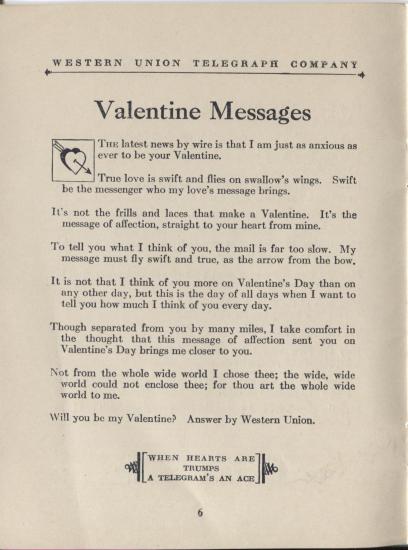Love on the line
Sending warm and fuzzies to a special someone this Valentine’s Day? If you’re not able to convey your affections in person, you’ll probably send a card or use some type of social media. Perhaps you’ll use your smart phone to order flowers or send a message containing a romantic emoticon. Whatever means you choose, you’ll be acting in the long tradition of adapting no-nonsense communications technology to meet social needs. For Valentine’s Day 2015, we decided to share a few fun items from the collections that people used to express love via telegraph and telephone lines.
When Samuel F. B. Morse sent “What Hath God Wrought” to Alfred Vail in May 1844, he intended the telegraph to be an instrument for important government and business messages. Ordinary people soon began sending telegrams of a personal nature and by the late 19th century Western Union became one of America’s most influential companies with offices all around the country. As the company developed marketing skills, they began offering services, such as specially designed telegrams, to boost business. This Valentine’s Day blank form above is one example. Your message would be printed on the form by the receiving office and hand-delivered by a Western Union messenger.
Not certain what to say to express your deepest feelings? Not to worry, Western Union was there to help. This handy book (below) from about 1920 provided several options to express your feelings in a way guaranteed to melt your Valentine’s heart.
In the early days, the Bell Telephone Company strongly discouraged the use of telephones for frivolous, social conversations. The telephone was meant for serious business. In an era when the system could only handle a limited number of calls, that made sense. The company faced an uphill battle as demonstrated by the simple fact that “lovers’ telephone” was a common name for two tin cans connected by a string. That concept carried over into the electrical era.
People paid little attention to the telephone company’s admonitions. This Valentine card printed by Raphael Tuck & Sons opens to show a young man calling his beloved and inviting her to “Name The Day,” perhaps for an opportunity to court or even wed.
This hand-made Valentine features an 1890s-era wall phone with an attached “Cupid’s Messages” phone book. The poem inside reads:
“Hello! Hello!!
Hurry up Central!
Don’t be so slow!
I’m all in a flutter,
my heart’s aglow.
Hello!
You say you love me,
do I love you?
Yes-Yes,
You ask, whether I
will ever be true:
Yes-Yes,
I dote on your words,
“I love you alone”
Whether whispered in ear
or heard on the ‘phone.”
For Valentine’s Day 1959, Western Union introduced CandyGram, “the sweetest message in the world.” Telephones had captured much of the market for personal communications by that time so the company began expanding its special services. A one-pound box of chocolates that could be sent anywhere in the country seemed a great idea for Valentine’s Day and the note accompanying this box says, “all reports on [CandyGram’s] acceptance by the public are most encouraging.” Perhaps. This package was sent to the staff of the Western Union office at 60 Hudson Street, New York City, with the company’s compliments—three days after Valentine’s Day. So it appears the company had at least a few left-overs.
These sweet artifacts reveal the ways in which real people have used communications technology to send personal Valentine greetings. Of course, it is rare that inventors anticipate exactly how society will adapt to and adopt their inventions and that can trigger subsequent development. The engineers who developed the ARPANet, forerunner to the Internet, never imagined that someday people would log onto a remote computer for the purpose of sending a Valentine’s Day gift to loved ones. Or to see items in the Smithsonian’s collections.
From all of us here at the museum, Happy Valentine’s Day!
P.S. For the record, no land-sharks were harmed in the making of this blog.
This post by Harold D. Wallace, curator of the Electricity Collections at the National Museum of American History, was originally published by the blog, O Say Can You See? Wallace is curator of the Electricity Collections. See more of the museum’s Western Union collections and archives and telegraphy collections. He has also blogged about a near electrical disaster and a Korean telegraph.
Posted: 13 February 2015
-
Categories:
American History Museum , Feature Stories , History and Culture












